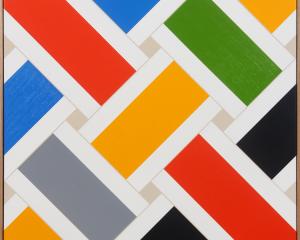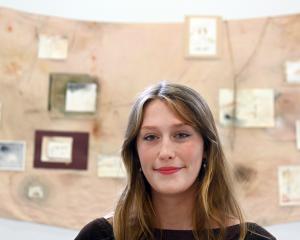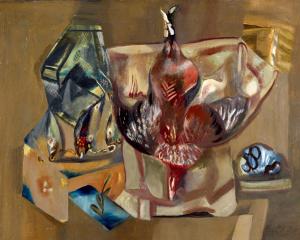
So many new ideas.
The past year in Dunedin has opened up many different areas of artistic practice for multi-media artist Sorawit Songsataya, in particular incorporating sound into their work.
So they are jetting off to Thailand, where they were born, to investigate the country’s traditional string instruments, having used the digital sound of a khim in their latest exhibition "Nirun" — named for the Thai word for eternal — at the Hocken Gallery.
"I want to go back and look at other instruments. It’ll be interesting to see how I’ll feel being back in my own country."
Having an entire year to dedicate to their work as the Frances Hodgkins fellow is something Songsataya is more than grateful for, knowing it has allowed them to develop works they would not have had a chance to otherwise.
"It’s been fantastic, I’ve learned so much. I would not have been able to do this on my own."
It meant Songsataya could develop their skills in working with limestone, a material they had been working in since 2019.

"I achieved certain things, but I’ve got so many new ideas emerging."
How sound can be incorporated with sculpture is one. Some of the cube-shaped limestone sculptures in the exhibition reference speakers, while the circular dish-like ones mimic the centre of a speaker and how water ripples out in circles.
"Sound frequency also travels like that too, it vibrates out. I’m curious as to what the sonic elements are doing to the rocks."
Songsataya’s group of stacked limestone columns are inspired by the columns from an ancient Thai temple built in the 13th century from laterite. Hardened sediment is covered with stucco.
"I borrowed that form and used available local materials, not only to think back to where I was born but through the material getting to know New Zealand, specifically the South Island, a little bit more, personally and also on a collective cultural level as well."
It has enabled them to learn more about the land and its cultural meaning for Māori as well as build a connection with mana whenua from three local runanga.
"Working through the materials is a way to get a better cultural understanding as well."

"I never intended to include them in any sort of art work but it makes sense now thinking back to places I’ve been and incorporating them here, this work I’ve made in Dunedin ."
They also included synthetic material like fake eyelashes and nails.
"Which represent a tiny bit of queer culture but also this act of preserving or keeping records of time. Not only me remembering the moment but also really considering what the materials are doing — all sorts of stones keep records of time but particularly Oamaru stone because they are sedimentary rocks, you can understand climatic history through them."
Songsataya also composed the sonic elements incorporated in the two videos that bookend their Hocken limestone installation.
Unnamed Islands focuses on the kotuku nesting site on the West Coast where the footage is juxtaposed with 3-D animations of scanned foraminifer shells — skeletal remains of microscopic sea organisms that contribute to the formation of limestone.
"It’s a bird species which is quite common in Thailand. They have become a way of connecting Aotearoa with Thailand as well."
It also references the different time scales on which things come into existence, the millions of years it takes limestone to form in comparison with birds and humans.

"What could be considered cousins of limestone, it’s not too far from the East Coast. There is a very different process of formation, this video speaks to a wider geological features and the richness of Central Otago."
Imposed on the video are Thai symbols of vowels which relate to the music they have composed for the work.
"I’m considering sound as way to communicate with the environment and the land as an alternative to language. I guess, trying to consider sound as a material which has a different capacity in film and space.
"Rocks, earth and soil are very solid and very heavy, they come with this density, whereas sound is weightless and travels through space."
Songsataya is also interested in how physical surfaces can influence or interact with frequency.
"Sound is very new. I just started learning how to make sound. It’s still at a very experimental stage. Its probably at its freest."
Another aspect of the exhibition is a three-channel holographic animation on LED blades, Summer Rain pulling visuals from the videos and images of thin slices of Otago schist as seen through a polarised light microscope.

"I‘m trying to embrace technology in a way that is not sitting in contrast with organic things or craftsmanship."
Songsataya has also worked alongside staff at the University of Otago’s department of geology to gain a deeper understanding of geological and geographical materials.
Together they hope the elements come together in an understanding of place and their position within those places.
"When you think of position, its nearness and varying degrees of closeness and distance. I’m more interested in the in-between space, it’s not clearly defined.
"It asks the viewer to be in the middle space, you are not just experiencing physical objects. That resonates back to a certain degree of me being between things culture, people, places, gender."
To see
Nirun, Sorawit Songsataya, Hocken Gallery, until June 17, 2023













